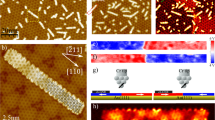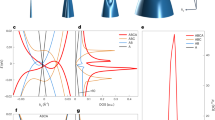Abstract
Collective magnetic properties are usually associated with the d or f electrons that carry the individual magnetic moments. A fully spin-polarized ground state based on π electrons has been predicted in half-filled flat-band organic materials, but has remained experimentally challenging to realize. Here we show that isolated tetracyano- p-quinodimethane molecules deposited on graphene epitaxially grown on Ru(0001) acquire charge from the substrate and develop a magnetic moment of 0.4 μB per molecule. The magnetic moment survives even when the molecules form into a dimer or a monolayer, with a value of 0.18 μB per molecule for the monolayer. The self-assembled molecular monolayer develops spatially extended spin-split electronic bands, and we visualized the ground-state spin alignment using spin-polarized scanning tunnelling microscopy. The observation of long-range magnetic order in an organic layer adsorbed on graphene paves the way for incorporating magnetic functionalities into graphene.
This is a preview of subscription content, access via your institution
Access options
Subscribe to this journal
Receive 12 print issues and online access
$209.00 per year
only $17.42 per issue
Buy this article
- Purchase on Springer Link
- Instant access to full article PDF
Prices may be subject to local taxes which are calculated during checkout





Similar content being viewed by others
References
Coleman, L. B. et al. Superconducting fluctuations and the Peierls instability in an organic solid. Solid State Commun. 12, 1125–1132 (1973).
Thomas, G. A. et al. Electrical conductivity of tetrathiafulvalenium-tetracyanoquinodimethanide (TTF-TCNQ). Phys. Rev. B 13, 5105–5110 (1976).
Peierls, R. Surprises in Theoretical Physics (Princeton Univ. Press, 1979).
Miller, J. S., Epstein, A. J. & Reif, W. M. Molecular/organic ferromagnets. Science 240, 40–47 (1988).
Jain, R. et al. High-temperature metal-organic magnets. Nature 445, 291–294 (2007).
Manriquez, J. M. et al. A room-temperature molecular/organic-based magnet. Science 252, 1415–1417 (1991).
Novoselov, K. & Geim, A. Electric field effect in atomically thin carbon films. Science 306, 666–669 (2004).
Batzill, M. The surface science of graphene: Metal interfaces, CVD synthesis, nanoribbons, chemical modifications, and defects. Surf. Sci. Rep. 67, 83–115 (2012).
Vázquez de Parga, A. L. et al. Periodically rippled graphene: Growth and spatially resolved electronic structure. Phys. Rev. Lett. 100, 056807 (2008).
Borca, B. et al. Potential energy landscape for hot electrons in periodically nanostructured graphene. Phys. Rev. Lett. 105, 036804 (2010).
Barja, S. et al. Self-organization of electron acceptor molecules on graphene. Chem. Commun. 46, 8198–8200 (2011).
Mao, J. et al. Tunability of supramolecular Kagome lattices of magnetic Pthalocyanines using graphene-based moiré patterns as templates. J. Am. Chem. Soc. 131, 14136–14137 (2009).
Tseng, T. C. et al. Charge-transfer-induced structural rearrangements at both sides of organic/metal interfaces. Nature Chem. 2, 374–379 (2010).
Kresse, G. & Hafner, J. Ab-initio molecular dynamics for liquid metals. Phys. Rev. B 47, 558–561 (1993).
Kresse, G. & Joubert, D. From ultrasoft pseudopotentials to the projector augmented-wave method. Phys. Rev. B 59, 1758–1775 (1999).
Stradi, D. et al. Role of dispersion forces in the structure of monolayer graphene on Ru surfaces. Phys. Rev. Lett. 106, 186102 (2010).
Stradi, D. et al. Electron localization in epitaxial graphene on Ru(0001) determined by moiré corrugation. Phys. Rev. B 85, 121404R (2012).
Tang, W., Sanville, E. & Henkelman, G. A grid-based Bader analysis algorithm without lattice bias. J. Phys. Condens. Matter 21, 084204 (2009).
Repp, J. et al. Imaging Bond formation between a gold atom and pentacene on an insulating surface. Science 312, 1196–1199 (2006).
Kondo, J. Effect of ordinary scattering on exchange scattering from magnetic impurity in metals. Phys. Rev. 169, 437–440 (1968).
Li, J. et al. Kondo scattering observed at a single magnetic impurity. Phys. Rev. Lett. 80, 2893–2896 (1998).
Madhavan, V. et al. Tunneling into a single magnetic atom: Spectroscopic evidence of the Kondo resonance. Science 280, 567–569 (1998).
Nagaoka, K. et al. Temperature dependence of a single Kondo impurity. Phys. Rev. Lett. 88, 077205 (2002).
Ternes, M., Heinrich, A. J. & Schneider, W-D. Spectroscopic manifestations of the Kondo effect on single adatoms. J. Phys. Condens. Matter 21, 053001 (2009).
Iancu, V., Deshpande, A. & Hla, S-W. Manipulation of the Kondo effect via two-dimensional molecular assembly. Phys. Rev. Lett. 97, 266603 (2008).
Fernández Torrente, I. et al. Vibrational Kondo effect in pure organic charge transfer assemblies. Phys. Rev. Lett. 101, 217203 (2008).
Temirov, R., Lassise, A., Anders, F. B. & Tautz, F. S. Kondo effect by controlled cleavage of a single-molecule contact. Nanotechnology 19, 065401 (2008).
Choi, T. et al. A single molecule Kondo switch: Multistability of tetracyanoethylene on Cu(111). Nano Lett. 10, 4175–4180 (2010).
Komeda, T. et al. Observation and electric current control of a local spin in a single-molecule magnet. Nature Commun. 2, 217 (2011).
Tasaki, H. Ferromagnetism in the Hubbard models with degenerate single electron ground states. Phys. Rev. Lett. 69, 1608–1611 (1992).
Mielke, A. Ferromagnetism in single band Hubbard models with a partially flat band. Phys. Rev. Lett. 82, 4312–4315 (1999).
Nagaoka, Y. Ferromagnetism in a narrow, half-filled band. Phys. Rev. 147, 392–405 (1966).
Arita, R. et al. Gate induced band ferromagnetism in an organic polymer. Phys. Rev. Lett. 88, 127202 (2002).
Wiesendanger, R. Spin mapping at the nanoscale and atomic scale. Rev. Mod. Phys. 81, 1495–1550 (2009).
Acknowledgements
Financial support by the Ministerio de Educación y Ciencia through projects CONSOLIDER-INGENIO 2010 on Molecular Nanoscience, FIS2010-18847, FIS2010-15127 and CTQ2010-17006 and Comunidad de Madrid through the programme NANOBIOMAGNET S2009/MAT1726 is gratefully acknowledged. S.B. would like to acknowledge the FPU Grant AP-2007-001157. D.S. and M.G. would like to acknowledge the FPI-UAM programme.
Author information
Authors and Affiliations
Contributions
The experiments were carried out primarily by M.G. and S.B., with important contributions by F.C. The calculations were performed mainly by D.S. with contributions by C.D. and M.A., and F.M. leading the theoretical approach. N.M. selected the specific chemical system. The data analysis was carried out by A.L.V.d.P., who also contributed to the writing of the manuscript. R.M. developed the physical idea and wrote the paper.
Corresponding author
Ethics declarations
Competing interests
The authors declare no competing financial interests.
Supplementary information
Supplementary Information
Supplementary Information (PDF 1296 kb)
Rights and permissions
About this article
Cite this article
Garnica, M., Stradi, D., Barja, S. et al. Long-range magnetic order in a purely organic 2D layer adsorbed on epitaxial graphene. Nature Phys 9, 368–374 (2013). https://doi.org/10.1038/nphys2610
Received:
Accepted:
Published:
Issue Date:
DOI: https://doi.org/10.1038/nphys2610
This article is cited by
-
Room-temperature long-range ferromagnetic order in a confined molecular monolayer
Nature Physics (2024)
-
Open questions in attochemistry
Communications Chemistry (2023)
-
Zeolite-like molecules: Promising dielectrics for two-dimensional semiconductors
Science China Materials (2023)
-
Intrinsically patterned corrals in monolayer Ag5Se2 and selective molecular co-adsorption
Nano Research (2022)
-
Ultrahigh-temperature ferromagnetism in MoS2 Moiré superlattice/graphene hybrid heterostructures
Nano Research (2021)



